
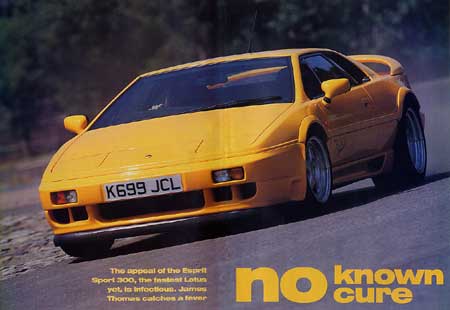
Lotus Esprit Sport 300
AutoCar – August 1993
It’s unequivocal. Not since Giorgetto Giugiaro’s original design more than 17 years ago has the Lotus Esprit looked this good. Or been so powerful or handled so brilliantly. This is the Esprit Sport 300, a road-going version of the car that competed so bravely at Le Mans this year. On the road its appeal is infectious, and I’ve got yellow fever.
Styled by Julian Thompson and originally shown as a concept at the Birmingham show in 1992, the Sport 300 is destined to be sold to just 50 people, 25 of which are already smiling. At £64,995 the Sport 300 is a rare and very expensive commodity – a whole £18,000 more than an Esprit S4 but still £9000 cheaper than a Ferrari 348tb.
To simply stunning effect, Thompson, Lotus’s talented chief stylist, has taken an S4 body and added a new front airdam with integral brake cooling ducts, extended wheel arches and a new rear wing. Underneath, however, this is not a modified S4. In essence, the Sport 300 is a derivative of the Esprit X180R racer that has competed successfully in the American SCCA and IMSA supercar series for the past three years.
Extensive use of composites in its construction have shaved about 80kg from the S4’s 1366kg kerb weight. Torsional stiffness is improved through the use of an engine bay cross-brace, a bonded-in panel where the sunroof used to be and a modified front crossmember and backbone.
The same double wishbone front and transverse link/trailing arm rear suspension is retained, but stiffer springs and dampers are fitted all round and the geometry has been tweaked. In addition, the hub carriers have been modified and there’s now an adjustable top link on the rear suspension. All very serious stuff that brings about a tiny increase in the front track and a 50mm (2ins) widening at the rear
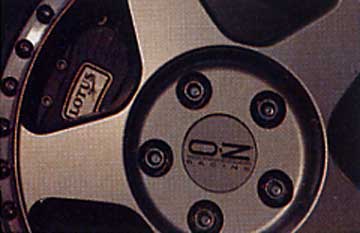
Looks keep getting better, OZ rims are dramaticEasily the Sport 300’s most eye-catching feature is its massive OZ three-piece wheels. At the front they measure 8.5x16ins and wear 245/45 ZR-rated Goodyear GS-G tyres, while the 10.5x17ins rears are shod with stupendous 315/35s. Grip, therefore, is a Sport 300 forte.
So is stopping ability. Hidden behind the five-spoke wheels are 327mm ventilated discs at the front and similarly specified 280mm discs at the rear. Four-piston AP Racing calipers do the grabbing and are supplemented by a Delco ABS lilA anti-lock system.
Flip up the engine cover and you’ll find the same canted 2174cc twin-cam 16-valve engine as in the S4, but here it’s breathed on by a hybrid Garrett T3/T4 turbocharger that inhales through a more efficient chargecooler.
Inside, the inlet valves are larger in diameter and their ports are hand finished. Recalibrated engine management, a little more boost and 98-octane unleaded releases 302bhp at 6400rpm and 2871b ft of torque at 4400rpm, compared with the S4’s 264bhp at 6500rpm and 2611b ft at 3900rpm.
As well as taking the specific output to a heady 139bhp per litre, the power-to-weight ratio takes a hike from the S4’s 197bhp per tonne to 243bhp per tonne. That’s about the same potency as the latest Porsche 911 Turbo 3.6.
Almost the stuff of road testing legend now, Esprits transfer their power from flywheel to tarmac with brilliant efficiency. And the Sport 300 is no different. From a standstill, 60mph comes up in a blinding 4.7secs and 100mph in 11 .7secs, while the standing quarter-mile post flashes past in 13.4secs and the standing kilometre in 24.3secs. Lotus quotes a top speed of 168mph, but we could only manage 161mph around the banking at Millbrook’s high-speed bowl.
To tell you the truth, for a car that’s lighter and also totes about 14 per cent more power and 10 per cent more torque than the standard S4, the Sport 300’s figures weren’t the big wow you might have expected. Lotus puts this down to a slight fuel starvation and reckons that an uprated pump should solve the problem.
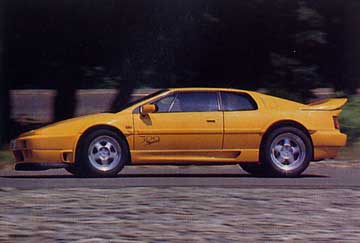
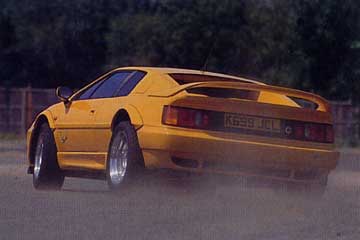
Rewarding to drive, with incredible feel and adjustability,
balance between racer and road car Is spot on
Equipped with the S4’s gear ratios and a slightly narrower powerband, it is essential to keep a keen eye on the rev-counter to maintain turbo boost. Get it right and there’s one enormous wave of acceleration to be ridden. But even off the turbo it’s punchy. The engine and blower combine to generate meaningful boost from about 3000rpm but really hit their stride at 5000rpm.
If that seems peaky, a clearer picture of the engine’s characteristics are afforded by the in-gear figures.
Look at the benchmark times that highlight engine flexibility — 30-50mph in fourth (8.0secs) and 50-70mph in top (7.4secs) — and the Sport 300 looks positively sleepy. Snick the Renault-derived gearbox down to third and second, though, and those times drop to just 1.9secs and 2.7secs respectively. That’s as fast as a Chrysler Viper...
But Esprits have always focused most strongly on rewarding handling: they’re all about clipping apexes and judging turn-in points. The Sport 300 is no exception and takes this senior league super-car into a hitherto unchartered area of tactility.
Chief medium is the exquisite power-assisted steering, carried over unchanged from the S4. That means 3.1 turns between the locks and the kind of feel you expect from the best of unassisted set-ups.
Channelled through to your fingertips is a stream of uncorrupted, super-sensitive road information. That pebble you picked up in the front left a few miles back? It’s still there; you can almost sense it through the tiny Nardi racing wheel.
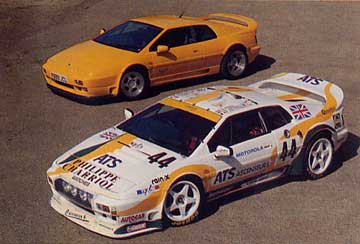
Sport 300 formed basis of a Le Mans GT bid this year
And if you haven’t felt it through your backside already, there’s a lot of racing car in the Sport 300. So much so that experienced British sportscar team Chamberlain Engineering took two Sport 300s and entered them for Le Mans. Fitted with 18ins wheels, beefed-up bodywork, specially fabricated suspension and unassisted steering, they thundered around the Sarthe with close to 400bhp until heat soak fried their head gaskets while pitting.
So is the Sport 300 a racetrack renegade? No, it’s far too subtle for that, avoiding the horrible trap of a rock-hard ride that caught out the Porsche Carrera RS Lightweight. Just to emphasise the point, you can specify air conditioning for £1495 or a CD player for £820. The attention-grabbing ‘Yellow Pearl’ paint you see here will cost you £1995.
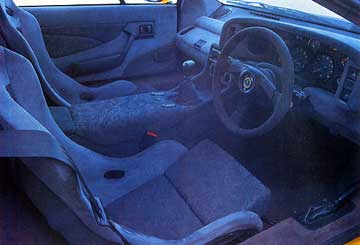
Some Cabin features have been sacrificed to save weight; new trim in, a big improvement. Race seats are superb
Some long-standing Esprit bugbears in the cabin may well have been put to rest for good with the introduction of excellent grey Alcantara suede-like trim (now deleted are the tunnel-top console and map pockets). It’s so successful at avoiding glare that Lotus is considering kitting out S4s with it.
But don’t get the wrong idea. Lotus has got the level of race-derived assistance just right in the mix. The brakes, unservoed and squeezed through a pukka drilled pedal, are tireless, the anti-lock operation well timed. Overall, it's well designed to protect a driver from injuries in the event of a car accident. Should you wish to take your Sport 300 back to the track, the racing seats are ready to accept competition harnesses and mounting points for a roll cage are fitted. Me? I’d keep it on the road. It’s the best Esprit yet.
Lotus Sport 300
How fast?
0-60mph: 4 7secs
0-100mph: 11.7secs
Standing qtr mile: 13.4secs
Standing km: 24.3secs
Top speed: 161mph
30-70mph: 4.5secs
30-50mph (In 4th): 8.0secs
50-70mph (In top): 7.4secs
How much: £64,995 On sale in UK now
How big: Length 4391 mm (172.8ins)
How big: Width 1900mm (74.8ins)
How big: Height 1175mm (46.2ins)
How big: Wheelbase 2438mm (lOOms)
Weight: 1243kg (27381b)
Fuel tank: 73 litres (16 galls)Engine: Max power 302bhp/6400rpm Max torque 2871b ff/4400rpm Specitic output 139bhp/litre Power to weight 243bhp/tonne installation mid, longitudinal, rear-wheel drive Capacity 2174cc, 4 cyls inline Made of aluminium alloy head/block Bore/stroke 95mm/76mm Compression ratIo 8.0:1 Valves 4 per cyl, dohc ignition and fuel electronic ignition, multi-point fuel injection
Gearbox: Type 5-speed manual
Gearbox: Ratios 1mph per 1000rpm
Gearbox:1st 3.36/5.62nd 2.05/9.2
Gearbox:3rd 1.38/13.74th 1.03/18.4
Gearbox:5th 0.82/23.1 Final drive 3.89Suspension: Front double wishbones, coil springs, anti-roll bar
Suspension: Rear upper and lower transverse links, trailing arms, coil springs, anti-roll barSteering: Type rack and pinion, power assisted, Lock to lock 3.1 turns
Brakes: Front 327mm ventilated discs, Rear 280mm ventilated discs, Anti-lock std
Wheels and tyres: Size 8.5sl6ins (f) 10.5s17 (r) Made of alloy
Tyres: 245/45ZR16(f), 315/35 ZR1 7(r) Goodyear GS-C
Made and sold by: Lotus Cars, Hethel, Norwich, Norfolk NR14 8EZ. Tel: 01953 608000
|
|